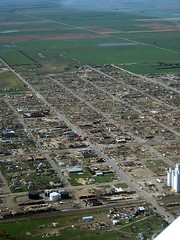How Greensburg is reducing carbon emissions and building green - from scratch

Posted June 6, 2008 at 1:30PM
With the federal government and an effective majority in Congress utterly unwilling to address global warming in any meaningful way, we must turn to states and localities for leadership. It doesn't get any more local than Greensburg, Kansas.
After Greensburg was destroyed by a severe tornado in May of 2007 (see left photo and my last post), the rural town of less than 1500 residents had difficult choices to make, including whether to rebuild at all. Frankly, the town needed a reason, a purpose.
Drawing on Midwestern earnestness, enlightened leadership, and skilled technical assistance, Greensburg has now found its raison d’etre in a profound mission: becoming a model of sustainability. As it is articulated in Greensburg’s new Sustainable Comprehensive Plan:
Over the last four decades this small rural farm town has been declining in population with a struggling economic base. In the wake of the disaster it became apparent that big changes would have to occur to sustain the town for future generations. The community set forth to rebuild a prosperous future through sustainable community design . . .
The community is proud of the rural quality of Greensburg. They expect development projects to reflect the unassuming feel that they cherish. However, they understand that replicating exactly what they had before would be taking a step backward. Instead, the community sees the great opportunity presented by the disaster. They want to rebuild a progressive, inclusive town that provides jobs, education and recreation to attract and retain a young generation of Greensburg residents. Like generations of Greensburg citizens before, they want to leave a legacy for their grandchildren and serve as an example for the Midwestern towns of tomorrow.
Here are some elements of this impressive plan:
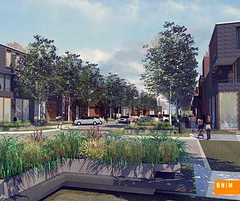 Green buildings. One of the first big decisions made by the town was that every municipal building would be constructed not just to meet LEED green building standards, but to meet the highest “platinum” level. They became the first community in the world to make that commitment, and each LEED-platinum building is projected to reduce carbon emissions by 42 percent compared to conventional buildings. These green buildings will include a new “business incubator” to help small start-up businesses.
Green buildings. One of the first big decisions made by the town was that every municipal building would be constructed not just to meet LEED green building standards, but to meet the highest “platinum” level. They became the first community in the world to make that commitment, and each LEED-platinum building is projected to reduce carbon emissions by 42 percent compared to conventional buildings. These green buildings will include a new “business incubator” to help small start-up businesses.
Beyond public buildings, the town is making resources and assistance available to everyone involved in rebuilding homes and other reconstruction. Key, hands-on support is being provided by a new nonprofit, Greensburg GreenTown.
New downtown. Greensburg’s new downtown will be mixed-use, architecturally diverse, and built for walkers, with welcoming sidewalks and street furniture, traffic calming, on-street parking instead of surface parking lots, and attractive native plantings and permeable pavers to facilitate stormwater control. 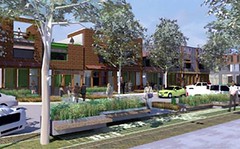 The plan encourages two- and three-story buildings to create a sense of place at the right scale for the size of the town, and accommodates the historic small-town model of providing housing above ground-floor shops.
The plan encourages two- and three-story buildings to create a sense of place at the right scale for the size of the town, and accommodates the historic small-town model of providing housing above ground-floor shops.
Walkability. The plan observes that “the desire to create a walkable community was clear from Greensburg’s residents. It helps create the small town feel that was cherished for generations in Greensburg.” The town’s relatively small size (roughly one mile across) is conducive to walking and, in addition to the downtown amenities mentioned above, and sidewalks throughout the town, the plan encourages a transect-based approach to maintain a walkable scale with higher residential densities closer to the core.
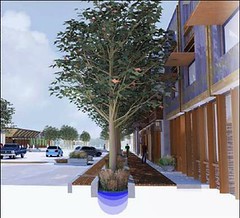 Transportation. There is no way a town like Greensburg is going to have urban-style public transportation. But being thoughtful about walkability, density, and the location of business and civic functions helps. It is impressive that the plan addresses the issue:
Transportation. There is no way a town like Greensburg is going to have urban-style public transportation. But being thoughtful about walkability, density, and the location of business and civic functions helps. It is impressive that the plan addresses the issue:
The rededication to creating a tight knit community that is walkable and with most necessities easily accessible are two of the most important steps in reducing unnecessary travel. The City’s new trail network and enhanced streetscapes should also encourage more pedestrian activity. To further reduce the need for fossil fuel based transportation it will be necessary for Greensburg to:
- Provide alternatives to traditional automobile transportation
- Minimize the need for personal automobile transportation
- Use land use codes to encourage local business and community interaction
- Provide maximum alternatives to mitigate the need for long-distance business travel
- Minimize travel distances for goods and services
Carbon footprint. Perhaps most impressive of all, the plan contains a detailed section on measuring and reducing Greensburg’s overall carbon footprint. Using 2006 records, the plan estimates the town’s pre-tornado carbon emissions from usage of electricity, natural gas and transportation fuels at 10,876 tons of carbon dioxide annually. The plan projects that, if the town were able to implement its elements plus an aggressive carbon reduction strategy (including use of wind-generated electricity and other elements I haven’t space to describe), emissions could be cut in half.
Realistic? Maybe not, in the short term. But it is remarkable that a town like Greensburg has adopted the vision.
There is so much more in the plan, and I invite interested readers to download it and soak it in. 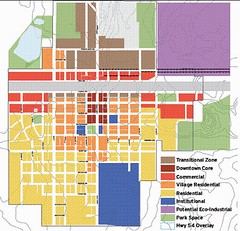 Hazard mitigation, in particular, stands out as so important for communities like Greensburg. There are also sections on economic development, energy, housing, infrastructure, and parks and green corridors. There is an outstanding section guiding future land use. A big chunk of the credit has to go to BNIM Architects for helping the town articulate its impressive vision.
Hazard mitigation, in particular, stands out as so important for communities like Greensburg. There are also sections on economic development, energy, housing, infrastructure, and parks and green corridors. There is an outstanding section guiding future land use. A big chunk of the credit has to go to BNIM Architects for helping the town articulate its impressive vision.
In some ways, Greensburg’s Sustainable Comprehensive Plan is the perfect small-scale bookend to complement the very large-scale and equally outstanding growth management plan for the area of Ontario surrounding Toronto.
I am actually a latecomer to this story, given its extensive press coverage, and I wonder how I missed it for so many months. Now that I’ve found Greensburg, I’ll be following their progress and rooting hard for them.
NOTE: After writing this on Thursday, for Friday morning publication, I read of serious tornado predictions for Kansas in the next few days. This must be extremely unsettling to the states' residents, none more than those in Greensburg. Let's hope for minimal injuries and damage.
